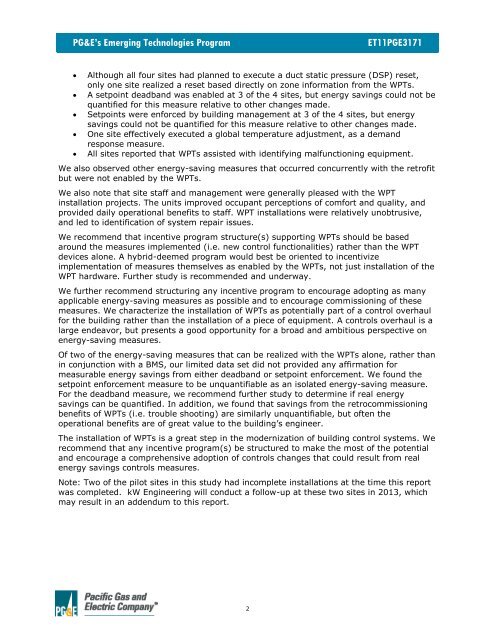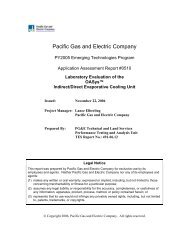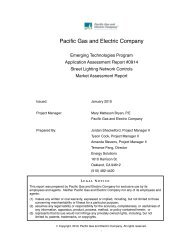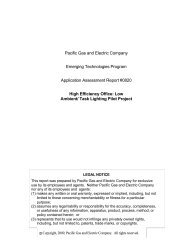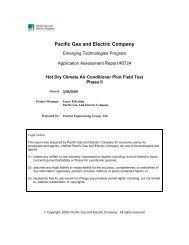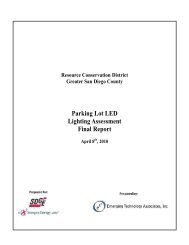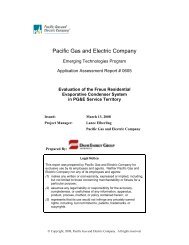PGE Wireless Pneumatic Thermostat ET Final Report.pdf
PGE Wireless Pneumatic Thermostat ET Final Report.pdf
PGE Wireless Pneumatic Thermostat ET Final Report.pdf
You also want an ePaper? Increase the reach of your titles
YUMPU automatically turns print PDFs into web optimized ePapers that Google loves.
PG&E’s Emerging Technologies Program <strong>ET</strong>11<strong>PGE</strong>3171<br />
Although all four sites had planned to execute a duct static pressure (DSP) reset,<br />
only one site realized a reset based directly on zone information from the WPTs.<br />
A setpoint deadband was enabled at 3 of the 4 sites, but energy savings could not be<br />
quantified for this measure relative to other changes made.<br />
Setpoints were enforced by building management at 3 of the 4 sites, but energy<br />
savings could not be quantified for this measure relative to other changes made.<br />
One site effectively executed a global temperature adjustment, as a demand<br />
response measure.<br />
All sites reported that WPTs assisted with identifying malfunctioning equipment.<br />
We also observed other energy-saving measures that occurred concurrently with the retrofit<br />
but were not enabled by the WPTs.<br />
We also note that site staff and management were generally pleased with the WPT<br />
installation projects. The units improved occupant perceptions of comfort and quality, and<br />
provided daily operational benefits to staff. WPT installations were relatively unobtrusive,<br />
and led to identification of system repair issues.<br />
We recommend that incentive program structure(s) supporting WPTs should be based<br />
around the measures implemented (i.e. new control functionalities) rather than the WPT<br />
devices alone. A hybrid-deemed program would best be oriented to incentivize<br />
implementation of measures themselves as enabled by the WPTs, not just installation of the<br />
WPT hardware. Further study is recommended and underway.<br />
We further recommend structuring any incentive program to encourage adopting as many<br />
applicable energy-saving measures as possible and to encourage commissioning of these<br />
measures. We characterize the installation of WPTs as potentially part of a control overhaul<br />
for the building rather than the installation of a piece of equipment. A controls overhaul is a<br />
large endeavor, but presents a good opportunity for a broad and ambitious perspective on<br />
energy-saving measures.<br />
Of two of the energy-saving measures that can be realized with the WPTs alone, rather than<br />
in conjunction with a BMS, our limited data set did not provided any affirmation for<br />
measurable energy savings from either deadband or setpoint enforcement. We found the<br />
setpoint enforcement measure to be unquantifiable as an isolated energy-saving measure.<br />
For the deadband measure, we recommend further study to determine if real energy<br />
savings can be quantified. In addition, we found that savings from the retrocommissioning<br />
benefits of WPTs (i.e. trouble shooting) are similarly unquantifiable, but often the<br />
operational benefits are of great value to the building’s engineer.<br />
The installation of WPTs is a great step in the modernization of building control systems. We<br />
recommend that any incentive program(s) be structured to make the most of the potential<br />
and encourage a comprehensive adoption of controls changes that could result from real<br />
energy savings controls measures.<br />
Note: Two of the pilot sites in this study had incomplete installations at the time this report<br />
was completed. kW Engineering will conduct a follow-up at these two sites in 2013, which<br />
may result in an addendum to this report.<br />
2


